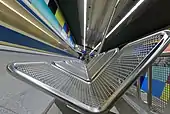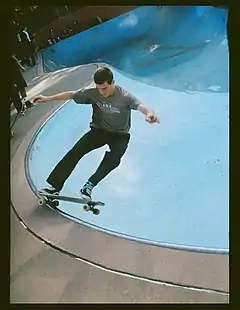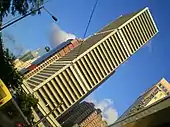Dutch angle
The Dutch angle, also known as Dutch tilt, canted angle, or oblique angle, is a type of camera shot which involves setting the camera at an angle on its roll axis so that the shot is composed with vertical lines at an angle to the side of the frame, or so that the horizon line of the shot is not parallel with the bottom of the camera frame.[1] This produces a viewpoint akin to tilting one's head to the side.[1] In cinematography, the Dutch angle is one of many cinematic techniques often used to portray psychological uneasiness or tension in the subject being filmed.[2] The Dutch tilt is strongly associated with the German movie scene during the expressionist movement, which used the Dutch angle extensively.[1][3]

Etymology
Usage of the word "Dutch" in this context does not signify a Dutch origin of the film technique, but rather uses the word as a pejorative adjective which gained currency in English following the Anglo-Dutch Wars of the 17th century. Similar word combinations include Dutch wife (a sex doll, prostitute), Dutch courage (boldness while drunk), Double Dutch (gibberish), Dutch agreement (a drunk agreement), Dutch leave (defecting) and Dutch treat, which refers to paying for yourself. As such, the term Dutch tilt or Dutch angle refers to the non-traditional, non-aligned frame. Several languages have subsequently calqued the term from English, such as the Spanish Plano holandés, even though these languages do not use Dutch in the same idiomatic sense, instead referring solely to the Dutch.[4]
Method
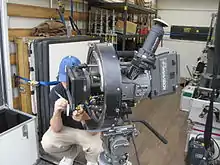
A Dutch angle is a camera shot in which the camera has been rotated relative to the horizon or vertical lines in the shot.[5] The primary use of such angles is to cause a sense of unease or disorientation for the viewer.[6] Many Dutch angles are static shots, but in a moving Dutch angle shot the camera can pivot, pan or track along the established diagonal axis for the shot.[3]
History
Dziga Vertov's 1929 experimental documentary Man with a Movie Camera contains uses of the Dutch angle, among other innovative techniques discovered by Vertov himself.[7]
The angle was widely used to depict madness, unrest, exoticism, and disorientation in German Expressionism. Montages of Dutch angles are often structured such that the tilts are horizontally opposed in each shot – for example, a right-tilted shot will be followed with a left-tilted shot, and so on.[8]
In Hollywood’s classic age, one filmmaker who used Dutch angles often was Alfred Hitchcock, whose early career included time at UFA studios in Germany; examples include Suspicion (1941), Strangers on a Train (1951), and The Man Who Knew Too Much (1956).
The 1949 film The Third Man makes extensive use of Dutch angle shots, to emphasize the main character's alienation in a foreign environment. Director Carol Reed has said that William Wyler gave him a spirit level after seeing the film, to sardonically encourage him to use more traditional shooting angles.[3][9]
Dutch angles were used extensively in the satirical 1960s Batman TV series (and its 1966 film spin-off) in which each villain had his or her own angle, as they were "crooked".[3][8]
Dutch angles are frequently used by film directors who have a background in the visual arts, such as Tim Burton (in Edward Scissorhands and Ed Wood), and Terry Gilliam (in Brazil, The Fisher King, 12 Monkeys, Fear and Loathing in Las Vegas and Tideland) to represent madness, disorientation, or drug psychosis. In his Evil Dead trilogy, Sam Raimi used Dutch angles to show that a character had become possessed by evil.[8] In Rainer Werner Fassbinder’s Die Sehnsucht der Veronika Voss (1982), a Dutch angle is used (twice) to convey an odd tension that strangers are exerting on the main character.
The Dutch angle is an overt cinematographical technique that can be overused.[10] The science-fiction film Battlefield Earth (2000), in particular, drew sharp criticism for its pervasive use of the Dutch angle. In the words of film critic Roger Ebert, "the director, Roger Christian, has learned from better films that directors sometimes tilt their cameras, but he has not learned why".[10]
Dutch angles are often used in horror video games, particularly those with static camera angles such as early entries in the Resident Evil and Silent Hill franchises.[11] Similar to their use in movies, these angles are used to bring about a feeling of unease in the player.[11]
Gallery of images taken with a Dutch angle
See also
References
- "Dutch angle - Hollywood Lexicon". Hollywood Lexicon. Retrieved 14 March 2017.
- "Should You Use A Dutch Angle Shot in Your Films? (Answer: Yes, But...)". No Film School. 2015-09-05. Retrieved 2019-08-05.
- Mamer, Bruce (2008). "Oblique Shot (Dutch Angle)". Film Production Technique: Creating the Accomplished Image. Belmont: Cengage Learning. pp. 9–10. ISBN 978-0-495-41116-1.
- Nicoline van der Sijs: Cookies, Coleslaw, and Stoops: The Influence of Dutch on the North American Languages, Amsterdam, 2009.
- "How Subjective Use of the Dutch Angle Camera Technique Evokes Disorienting Doubt Within a Scene". Laughing Squid. 2018-04-20. Retrieved 2019-08-05.
- Christopher J. Bowen, Roy Thompson (2013). Grammar of the Shot. Taylor & Francis. p. 82. ISBN 978-0240526010. Retrieved 26 December 2014.
- Taplin, Phoebe; RBTH, special to (2014-08-14). "Dziga Vertov: Man with a movie camera". www.rbth.com. Retrieved 2019-08-05.
- ScreenPrism. "The Filmmaker's Handbook: What is a Dutch Tilt". the-take.com. Retrieved 2021-02-02.
- Charles Thomas Samuels, Encountering Directors, 1972 - interview with Carol Reed, excerpt at wellesnet.com
- Ebert, Roger (2000-05-12). "Battlefield Earth". Chicago Sun-Times. Retrieved 2006-07-29.
- "They Call Me Spooky: The Spookiest Camera Angles in the Resident Evil Remake". Destructoid. Retrieved 2019-08-05.
External links
 Media related to Dutch angle at Wikimedia Commons
Media related to Dutch angle at Wikimedia Commons
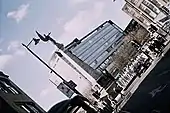
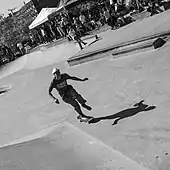
.jpeg.webp)

